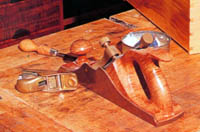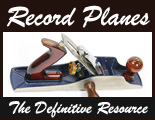Plane Works – Gunmetal Infill Panel Planes
The following text was taken from a three-page promotional leaflet which was acquired in 1992. Originally there were no pictures with the leaflet and the ones here were sourced from the magazine “Australian Wood Review”.
While it is understood that the company no longer produces planes on a full-time basis, they may still have finished hand planes and castings in stock. Its not known if the contact details given at the bottom of the leaflet is still relevant.
Plane Works has been listed in the Handplane Central archives as “Contemporary Planemakers” until it is known for sure just what their current status is.
The Leaflet…
 LEFT: Plane No. 5 3/4; in gunmetal.
LEFT: Plane No. 5 3/4; in gunmetal.
Plane Works is a partnership of two independent furniture designers and makers working in Melbourne. In late 1989 we sought to develop and produce a high quality hand plane which would achieve the high level of performance required to work some Australian timbers. We are now convinced we have accomplished this with our P5 3/4 hand plane.
In the process of developing the plane, we have conducted research on the finer hand planes manufactured in the past. We also took careful note of the aspects of hand plane design which promote optimum performance. In the course of our research we consulted craftsmen on our designs. All of the above resulted in a evolution of our product to its current form. We realise that our current product may still not be the ultimate plane, and we shall incorporate developments as they avail themselves.
Special Features
1. Solid Cast Phosphorus Bronze Base: Heavy and extremely stable, this metal has the added benefits of high wear resistance and very low surface friction, giving the plane silky smoothness of operation.
2. Special Tool Steel Blade: The highest grade of oil tool steel was chosen for this plane. After the bevel was milled, the cutting half was hardened and tempered to give optimum keenness of edge, combined with high wear resistance. The blades are 5mm thick, allowing chatter-free operation.
3. Cap Iron: Made from 3mm thick steel, the cap iron is lapped to precision flatness to marry perfectly to the back of the blade and provide perfect chip formation.
4. Adjusting Mechanism: This is the brain of the tool. We borrowed the brilliant idea used in the classic hand planes manufactured by the Norris company of London. The mechanism was made to exacting standards to provide very positive blade adjustment, free from slack. Double screw operation, incorporating left-hand thread, was chosen for its accuracy over continuous use. The cap iron screw was turned to fit exactly into the adjusting mechanism’s carrier ring, again preventing slack in blade height adjustment.
5. Wooden infill: A plane of this quality deserves something special for its handles. We choose only the highest quality timber for the blanks and select for colour and interesting figure. We feel that careful selection of timber improves the plane’s general qualities. The infill is shaped by hand to fit the client’s requirements. After the infill is sanded (to 800 + grit) it is immersed in a concoction of oils and turpentine. This helps to stabilise the wood.
6. Throat: The degree of tear-out in the timber being planed is directly affected by the width of the throat of the plane. To minimise the tear-out using our planes we carefully file out the throat of each plane to give the narrowest width possible and still allow excellent chip production. To this end we also use parallel steel for our blades so the throat will remain unchanged over the lifetime of the blade.
7. Precision: It is possible to plane surfaces to a dead flat finish only if the plane is finished with its surfaces dead flat. We go to extremesto provide a plane with all critical surfaces flat.
(a) The base is milled flat, the infill inserted, and the base again flattened after completion of the plane, now by honing on a dead flat cast iron table. The finished base is flat to within a thou (0.025mm).
(b) The blade’s back is honed on diamond lapping plates and sharpened to razor sharpness.
(c) The frog is planed carefully flat and then tested with a precision straight-edge.
 All the above considerations have enabled full-width shavings of only 0.018mm (0.0007″) to be taken from the entire length of boards.
All the above considerations have enabled full-width shavings of only 0.018mm (0.0007″) to be taken from the entire length of boards.
The Plane Works partnership is delighted to introduce the following exciting developments in our range of precision tools.
1. The incredible “No.9” gunmetal jointer plane, which will produce the most precise finish to any board edge and result in perfect joins.
2. The SP-1, a completely new design for a scraper plane resulting in an extremely versatile unit with extra-wide cutter.
3. Extensive research has resulted in the most brilliant plane blades available anywhere. These blades are made from steel alloy made by a space-age metallurgical process. The result is a blade that is considerably stronger, tougher, more wear resistant and hardened to an amazing Rc 65.
The Plane Works partnership is committed to producing specialised tools of the highest quality possible and will continue to search for new tools to make available to a discerning clientele.
Committed to excellence; yours,
Anton Gerner
Leslie Gross
Plane Works
219 Argyle Street
Fitzroy. 3065.
Ph: 419 0936
…STOP PRESS– Now in the prototyping stage is our latest tool, the fully adjustable, compound angle, skew blade, bronze shooting board with adjustable stops and fences. Details to be announced soon.






